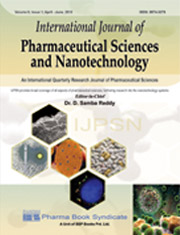Effect of Permeation Enhancers on Transdermal Delivery of Venlafaxine Hydrochloride from Carbopol Gel
DOI:
https://doi.org/10.37285/ijpsn.2013.6.1.9Abstract
In this study, we investigated the effect of different permeation enhancers at different concentrations viz. oleic acid, olive oil and castor oil from transdermal gel for transdermal delivery of venlafaxine, a newer antidepressant. It is a first line drug in the treatment of depression and inhibits brain serotonin and norepinephrine neuronal reuptake. It is also used in the treatment of anxiety disorders. Transdermal delivery of venlafaxine hydrochloride may result in enhanced patient compliance by reducing the incidence of the undesirable GI problems associated with its multiple oral dosing. The differential scanning colorimetry study was used to investigate the drug-polymer interaction. The prepared gels were evaluated for several physico-chemical parameters such as drug content, spreadability, pH, viscosity and physical appearance to justify their suitability for topical use. The in vitro permeation studies were performed by using Franz diffusion cell and rat skin as a semi permeable membrane. This indicate that penetration enhancers in 5% v/w concentration enhance the permeation of venlafaxine hydrochloride but oleic acid show maximum permeation rate was 197 µg/cm2/hr as compared to olive oil (154.69µg/cm2/hr) and castor oil (175.8µg/cm2/hr). It is further optimized by increasing the concentration of permeation enhancer at levels as high as 10% v/w and 15% v/w. The result indicates that increase in the concentration of enhancer enhances the percutaneous permeation of venlafaxine. Oleic acid was found to be superior to olive oil and castor oil implying the ability of oleic acid to increase the drug diffusion by SC lipid disruption and increase partition coefficient into SC. The permeation rate of venlafaxine hydrochloride with 15% v/w oleic acid was higher (rat abdominal skin flux = 8.507 µg/cm2/h) than with 15% v/w olive oil and castor oil. These studies show promising potential of transdermal patches of venlafaxine.
Downloads
Metrics
Keywords:
Venlafaxine, permeation enhancers, carbopol 934P, transdermalDownloads
Published
How to Cite
Issue
Section
References
regni C, Chiappetta D, Faiden N, Carlucci A, Garcia R and Rasquali R (2008). Release study of diclofenac from new carbomer gels. Pak J Pharm Sci 21: 12-16.
Bymaster FP, Dreshfield-Ahmad LJ and Threlkeld PG (2001). Comparative affinity of duloxetine and venlafaxine for serotonin and norepinephrine transporters in vitro and in vivo, human serotonin receptor subtypes, and other neuronal receptors. Neuropsychopharmacology 25: 871–80.
Cornwell PA and Barry BW (1994). Sesquiterpene components of volatile oils as skin penetration enhancers for the hydrophilic permeant 5-fluorouracil. J PharmPharmacol 46: 261-269.
Cunningham LA (1997). Once daily venlafaxine extended release (XR) and venlafaxine immediate release (IR) in outpatient with major depression. Ann ClinPsychiatory 9: 157- 64.
Dey S, Mazumber B and Patel JR (2009).Enhanced percutanous permeability of acyclovir DMSO from transdermal gel formulation. Int J Pharm Sci and Drug Res 1: 13-18.
Evangelos K, Konstantinos L and Stavros P (2006). Sustained release formulation for Venlafaxine hydrochloride. US Patent Application 20060182797.
Garg AK, NegiLM and Chauhan M (2010). Gel containing ethosomal vesicles for transdermal delivery of aceclofenac. International Journal of Pharmacy and Pharmaceutical Sciences 2: 102 -109.
Jain AK, Thomas NS and Panchagnula R (2002).Transdermal drug delivery of imipramine hydrochloride. I. Effect of terpenes. J Control Release 79: 93–101.
Jain S, Padsalg BD, Patel AK and Moale V (2007). Formulation development and evaluation of Flucanzole gel in various polymer bases. Asian Journal of Pharmaceutics 1: 63-68.
Laurence L and Brunton J (2006). Goodman and Gilman's The Pharmacological Basis of Therapeutics, McGraw-Hill Medical Publishing Division, New York.
Nemeroff CB, Entsuah R, Benattia I, Demitrack M, Sloan DM and Thase ME (2008). Comprehensive analysis of remission with venlafaxine versus SSRIs. Biol Psychiatry 63: 424–434.
Sherman DM, Clark JC, Lamer JU and White SA (2002). Extended release formulation of venlafaxine hydrochloride. US Patent 6419958.
Sindrup SH, Bach FW, Yonkers KA, Kunz NR, Pherson MM and Upton GV (2001). Venlafaxine in the treatment of premenstrual dysphoric disorder. ObstetGynecol 9: 737-744.
Sindrup SH, Bach FW, Madsen C, Gram LF and Jensen TS (2003). Venlafaxine versus imipramine in painful polyneuropathy: a randomized, controlled trial. Neurology 60: 1284–1289.
Singh GS, Bijyana G, Dave KK and Vanita S (2008). Screening of Venlafaxine hydrochloride for transdermal delivery: Passive diffusion and iontophorosis. AAPS Pharm SciTech 9: 791- 7.
Stahl SM, Grady MM, Moret C and Briley M (2005). SNRIs: their pharmacology, clinical efficacy and tolerability in comparison with other classes of antidepressants.CNS Spectr 10: 732–747.
Yardley JP, Husbands GE and Stack G (1990). 2-Phenyl-2-(1-hydroxycycloalkyl) ethylamine derivatives: synthesis and antidepressant activity. J Med Chem 33: 2899–905.






